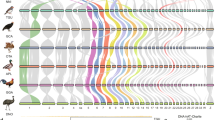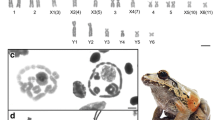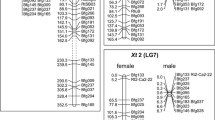Abstract
There are regional variations of sex chromosome morphologies in the Japanese wrinkled frog, Rana rugosa (2n = 26): heterogametic ZZ/ZW-type and XX/XY-type sex chromosomes, and two different types of homomorphic sex chromosomes. To search for homology between the ZW and XY sex chromosomes and the chromosome rearrangements that have occurred during sex chromosomal differentiation in R. rugosa, we performed chromosome mapping of sexual differentiation genes for R. rugosa by FISH. Three genes, AR, SF-1/Ad4BP and Sox3, were localized to both the ZW and XY chromosomes, and their locations were all different between the Z and W and between the X and Y. AR and SF-1/Ad4BP were located on the short arms of the W and X and the long arms of Z and Y, and Sox3 was mapped to the different locations on the long arms between the Z and W and between the X and Y, probably as a result of multiple rearrangements that occurred during the process of sex chromosome differentiation. However, the chromosomal locations of three genes were almost consistent between the Z and Y and between the W and X, indicating that the Z and Y chromosomes and the W and X chromosomes were respectively derived from the same origins. Dmrt1, which is located on avian sex chromosomes, was localized to autosomes in R. rugosa with both the ZW and XY sex chromosomes, suggesting that Dmrt1 might not be related to sex determination in this species.
Similar content being viewed by others
References
Aoyama S, Shibata K, Tokunaga S et al. (2003) Expression of Dmrt1 protein in developing and in sex-reversed gonads of amphibians. Cytogenet Genome Res 101: 295–301.
Courtet M, Flajnik M, Du Pasquier L (2001) Major histocompatibility complex and immunoglobulin loci visualized by in situ hybridization on Xenopus chromosomes. Dev Comp Immunol 25: 149–157.
Crews D (2003) Sex determination: where environment and genetics meet. Evol Dev 5: 50–55.
Denny P, Sweft S, Brand N et al. (1992) A conserved family of genes related to the testis determining gene, SRY. Nucleic Acids Res 20: 2887.
Fukada S, Tanaka M, Iwaya M et al. (1995) The Sox gene family and its expression during embryogenesis in the teleost fish, medaka (Oryzias latipes). Dev Growth Differ 37: 379–385.
Gordon M (1927) The genetics of a viviparous top-minnow Platypoecilus; the inheritance of two kinds of melanophores. Genetics 12: 253–283.
Gordon M (1947) Genetics of Platypoecilus maculatus. IV. The sex determining mechanism in two wild populations of the Mexican platyfish. Genetics 32: 8–17.
Green DM (1988) Cytogenetics of the endemic New Zealand frog, Leiopelma hochstetteri: extraordinary supernumerary chromosome variation and a unique sex-chromosome system. Chromosoma 97: 55–70.
Guan G, Kobayashi T, Nagahama Y (2000) Sexually dimorphic expression of two types of DM (Doublesex/Mab-3)-domain genes in a teleost fish, the Tilapia (Oreochromis niloticus). Biochem Biophys Res Commun 272: 662–666.
Handley L-JL, Ceplitis H, Ellegren H (2004) Evolutionary strata on the chicken Z chromosome: implications for sex chromosome evolution. Genetics 167: 367–376.
Hayes TB (1998) Sex determination and primary sex differentiation in amphibians: genetic and developmental mechanisms. J Exp Zool 281: 373–399.
Hillis DM, Green DM (1990) Evolutionary changes of heterogametic sex in the phylogenetic history of amphibians. J Evol Biol 3: 49–64.
Iwade R, Mauo K, Okada G, Nakamura M (2008) Elevated expression of P450c17 (CYP17) during testicular formation in the frog. Gen Comp Endocrinol 155: 79–87.
Kato T, Matsui K, Takase M et al. (2004) Expression of P450 aromatase protein in developing and in sex-reversed gonads of the XX/XY type of the frog Rana rugosa. Gen Comp Endocrinol 137: 227–236.
Kawai A, Nishida-Umehara C, Ishijima J et al. (2007) Different origins of bird and reptile sex chromosomes inferred from comparative maping of chicken Z-linked genes. Cytogenet Genome Res 117: 92–102.
Kawano K, Miura I, Morohashi K et al. (1998) Molecular cloning and expression of the SF-1/Ad4BP gene in the frog, Rana rugosa. Gene 222: 169–176.
Kawano K, Furusawa S, Matsuda H et al. (2001) Expression of steroidogenic factor-1 in frog embryo and developing gonad. Gen Comp Endocrinol 123: 13–22.
Kettlewell JR, Raymond CS, Zarkower D (2000) Temperature-dependent expression of turtle Dmrt1 prior to sexual differentiation. Genesis 26: 174–178.
Kochan KJ, Wright DA, Schroeder LJ et al. (2003) Genetic linkage maps of the West African clawed frog Xenopus tropicalis. Dev Dyn 226: 99–102.
Koyano S, Ito M, Takamatsu N et al. (1997) The Xenopus Sox3 gene expressed in oocytes of early stages. Gene 188: 101–107.
Krylov V, Mácha J, Tlapáková T, et al. (2003) The c-SRC1 gene visualized by in situ hybridization on Xenopus laevis chromosomes. Cytogenet Genome Res 103: 169–172.
Lahn BT, Page DC (1997) Functional coherence of the human Y chromosome. Science 278: 675–680.
Lahn BT, Page DC (1999) Four evolutionary strata on the human X chromosome. Science 286: 964–967.
Marchand O, Govoroun M, D’Cotta H, et al. (2000) DMRT1 expression during gonadal differentiation and spermatogenesis in the rainbow trout, Oncorhynchus mykiss. Biochim Biophys Acta 1493: 180–187.
Matsubara K, Tarui H, Toriba M et al. (2006) Evidence for different origin of sex chromosomes in snakes, birds, and mammals and step-wise differentiation of snake sex chromosomes. Proc Natl Acad Sci U S A 103: 18190–18195.
Matsuda Y, Chapman VM (1995) Application of fluorescence in situ hybridization in genome analysis of the mouse. Electrophoresis 16: 261–272.
Matsuda Y, Harada Y-N, Natsuume-Sakai S et al. (1992) Location of the mouse complement factor H gene (cfh) by FISH analysis and replication R-banding. Cytogenet Cell Genet 61: 282–285.
Matsuda M, Nagahama Y, Shinomiya A et al. (2002) DMY is a Y-specific DM-domain gene required for male development in the medaka fish. Nature 417: 559–563.
Matsuda Y, Nishida-Umehara C, Tarui H et al. (2005) Highly conserved linkage homology between birds and turtles: birds and turtle chromosomes are precise counterparts of each other. Chromosome Res 13: 601–615.
Miura I, Ohtani H, Kashiwagi A et al. (1996) Structural differences between XX and ZW sex lampbrush chromosomes in Rana rugosa females (Anura: Ranidae). Chromosoma 105: 237–241.
Miura I, Ohtani H, Hanada H et al. (1997) Evidence for two successive pericentric inversions in sex lampbrush chromosomes of Rana rugosa (Anura: Ranidae). Chromosoma 106: 178–182.
Miura I, Ohtani H, Nakamura M et al. (1998) The origin and differentiation of the heteromorphic sex chromosomes Z, W, X, and Y in the frog Rana rugosa, inferred from the sequences of a sex-linked gene, ADP/ATP translocate. Mol Biol Evol 15: 1612–1619.
Morrish BC, Sinclair AH (2002) Vertebrate sex determination: many means to an end. Reproduction 124: 447–457.
Nakajima T, Takase M, Miura I et al. (2000) Two isoforms of FTZ-F1 messenger RNA: molecular cloning and their expression in the frog testis. Gene 248: 203–212.
Nanda I, Shan Z, Schartl M et al. (1999) 300 million years of conserved synteny between chicken Z and human chromosome 9. Nat Genet 21: 258–259.
Nanda I, Haaf T, Schartl M et al. (2002a) Comparative mapping of Z-orthologous genes in vertebrates: implications for the evolution of avian sex chromosomes. Cytogenet Genome Res 99: 178–184.
Nanda I, Kondo M, Hornung U et al. (2002b) A duplicated copy of DMRT1 in the sex-determining region of the Y chromosome of the medaka, Oryzias latipes. Proc Natl Acad Sci USA 99: 11778–11783.
Nishioka M, Hanada H, Miura I et al. (1994) Four kinds of sex chromosomes in Rana rugosa. Sci Rep Lab Amphibian Biol, Hiroshima Univ 13: 1–34.
Ogata M, Ohtani H, Igarashi T et al. (2003) Change of the heterogametic sex from male to female in the frog. Genetics 164: 613–620.
Ogata M, Hasegawa Y, Ohtani H et al. (2008) The ZZ/ZW sex-determining mechanism originated twice and independently during evolution of the frog, Rana rugosa. Heredity 100: 92–99.
Ohno S (1967) Sex Chromosomes and Sex-Linked Genes. Berlin: Springer.
Ohtani H, Miura I, Ichikawa Y (2003) Role of aromatase and androgen receptor expression in gonadal sex differentiation of ZW/ZZ-type frogs, Rana rugosa. Comp Biochem Physiol Part C 134: 215–225.
Oshima Y, Kato T, Wang D et al. (2006) Promoter activity and chromosomal location of the Rana rugosa P450 aromatase (CYP19) gene. Zool Sci 23: 79–85.
Schmid M, Steinlein C (2001) Sex chromosomes, sex-linked genes, and sex determination in the vertebrate class Amphibia. In: Scherer G, Schmid M, eds., Genes and Mechanisms in Vertebrate Sex Determination. Basel: Birkhäuser Verlag, pp. 143–176.
Shan Z, Nanda I, Wang Y et al. (2000) Sex-specific expression of an evolutionarily conserved male regulatory gene, DMRT1, in birds. Cytogenet Cell Genet 89: 252–257.
Shetty S, Kirby P, Zarkower D et al. (2002) DMRT1 in a ratite bird: evidence for a role in sex determination and discovery of a putative regulatory element. Cytogenet Genome Res 99: 245–251.
Shibata K, Takase M, Nakamura M (2002) The Dmrt1 expression in sex-reversed gonads of amphibians. Gen Comp Endocrinol 127: 232–241.
Sinclair AH, Berta P, Palmer MS et al. (1990) A gene from the human sex-determining region encodes a protein with homology to a conserved DNA-binding motif. Nature 346: 240–244.
Smith CA, Sinclair AH (2004) Sex determination: insights from the chicken. Bio essays 26: 120–132.
Smith CA, McClive PJ, Western PS et al. (1999) Conservation of a sex-determining gene. Nature 402: 601–602.
Smith JJ, Voss SR (2006) Gene order data from a model amphibian (Ambystoma): new perspectives on vertebrate genome structure and evolution. BMC Genomics 7: 219.
Smith JJ, Voss SR (2007) Bird and mammal sex-chromosome orthologs map to the same autosomal region in a salamander (Ambystoma). Genetics 177: 607–613.
Smith JJ, Kump DK, Walker JA et al. (2005) A comprehensive expressed sequence tag linkage map for tiger salamander and Mexican axolotl: enabling gene mapping and comparative genomics in Ambystoma. Genetics 171: 1161–1171.
Sugita J, Takase M, Nakamura M (2001) Expression of Dax-1 during gonadal development of the frog. Gene 280: 67–74.
Suzuki T, Kurosaki T, Shimada K et al. (1999) Cytogenetic mapping of 31 functional genes on chicken chromosomes by direct R-banding FISH. Cytogenet Cell Genet 87: 32–40.
Takahashi E, Hori T, O’Connell P et al. (1990) R-banding and nonisotopic in situ hybridization: precise localization of the human type II collagen gene (COL2A1). Hum Genet 86: 14–16.
Takase M (1998) Differences in genetic backgrounds affecting gonadal differentiation between two local populations of the Japanese wrinkled frog (Rana rugosa). Anat Embryol 198: 141–148.
Takase M, Noguchi S, Nakamura M (2000) Two Sox9 messenger RNA isoforms: isolation of cDNAs and their expression during gonadal development in the frog Rana rugosa. FEBS Lett 466: 249–254.
Tsuda Y, Nishida-Umehara C, Ishijima J et al. (2007) Comparison of the Z and W sex chromosomal architectures in elegant crested tinamou (Eudromia elegans) and ostrich (Struthio camelus) and the process of sex chromosome differentiation in palaeognathous birds. Chromosoma 116: 159–173.
Wallace H, Badawy GMI, Wallace BMN (1999) Amphibian sex determination and sex reversal. Cell Mol Life Sci 55: 901–909.
Yamamura Y, Aoyama S, Oshima Y et al. (2005) Molecular cloning and expression in gonad of Rana rugosa WT1 and Fgf9. Zool Sci 22: 1045–1050.
Author information
Authors and Affiliations
Corresponding author
Rights and permissions
About this article
Cite this article
Uno, Y., Nishida, C., Oshima, Y. et al. Comparative chromosome mapping of sex-linked genes and identification of sex chromosomal rearrangements in the Japanese wrinkled frog (Rana rugosa, Ranidae) with ZW and XY sex chromosome systems. Chromosome Res 16, 637–647 (2008). https://doi.org/10.1007/s10577-008-1217-7
Received:
Revised:
Accepted:
Published:
Issue Date:
DOI: https://doi.org/10.1007/s10577-008-1217-7




